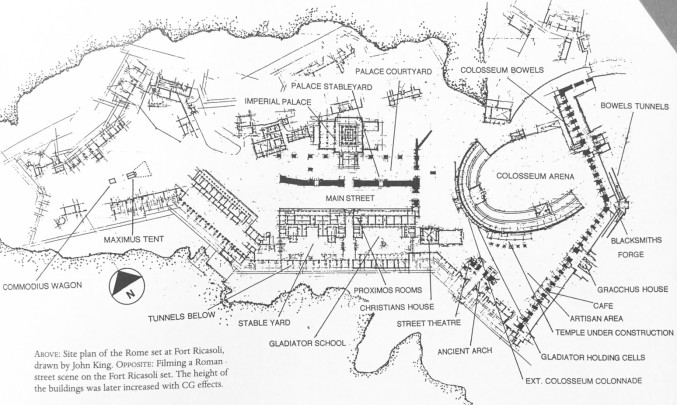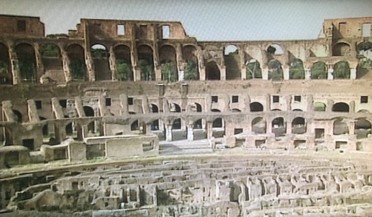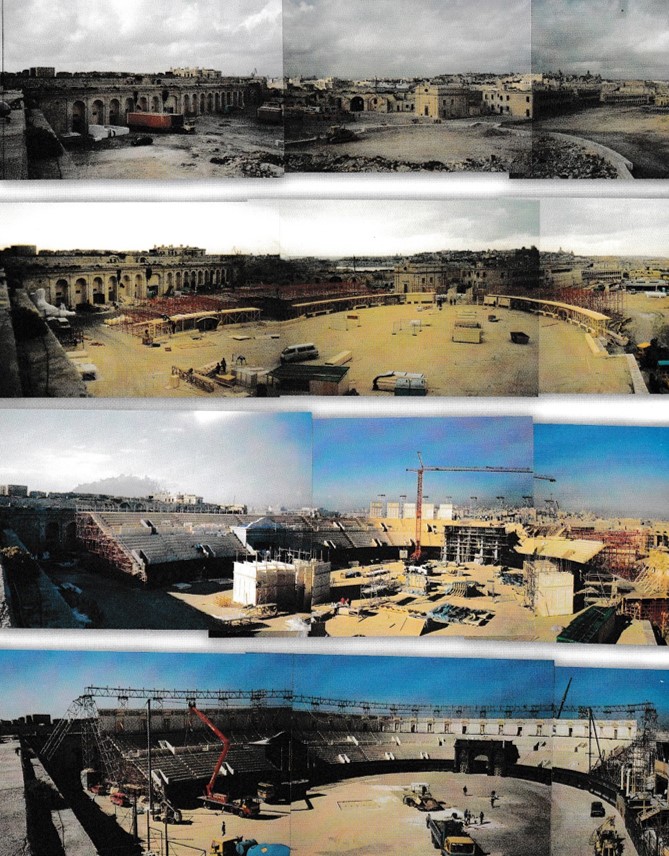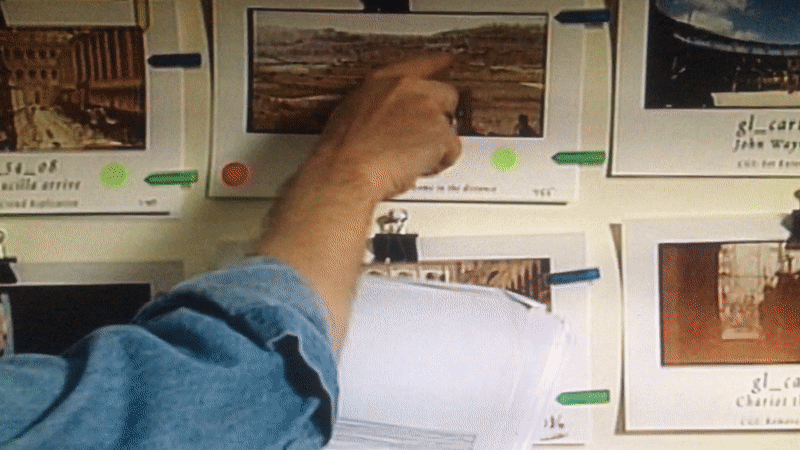 Gladiator is a historical epic drama with a fictional plot revolving around the Roman empire between the 1st and 2nd century AD. The movie is directed by one of the most influential directors of our time, Sir Ridley Scott. Starring Russell Crowe, Richard Harris, Oliver reed and released in 2000, Gladiator is known for its historical reinterpretation and depiction of Rome and its culture that only historians have so managed to accurately record and debate along the centuries. The plot is a story of a fictional character general Maximus who is to become the regent of Rome but is betrayed by the royal blood. Will he bring back Roman to the hands of the Roman senate to where it is to belong? Will he win back the name and dignity he lost?
Gladiator is a historical epic drama with a fictional plot revolving around the Roman empire between the 1st and 2nd century AD. The movie is directed by one of the most influential directors of our time, Sir Ridley Scott. Starring Russell Crowe, Richard Harris, Oliver reed and released in 2000, Gladiator is known for its historical reinterpretation and depiction of Rome and its culture that only historians have so managed to accurately record and debate along the centuries. The plot is a story of a fictional character general Maximus who is to become the regent of Rome but is betrayed by the royal blood. Will he bring back Roman to the hands of the Roman senate to where it is to belong? Will he win back the name and dignity he lost?

I would like to initiate this presentation with this quote, ‘Rome was not built in a day’. Depicting the idea of a historical drama is an ambitious project for a movie which involves accuracy of historical data and research about the era of the Romans. The challenge in gladiator is the choice of genre. It is a tremendous work which means revisiting the classical subjects and decode the ancient world of Rome. The world of Rome in the eyes of director Ridley Scott is massive grand classical wealthy powerful and empowering. He creates his world to express his ideologies of the roman civilization as not only being decadent, totalitarian powerful and conquering but also something that is dystopian, contrasting urban and rural, elite and the commons and he does so by using architecture to weave his context.
While referencing history, Director Scott has first drawn to the inspiration he derived from Jean-Leon Gerome’s well known Romanesque gladiatorial paintings from 18th century, Police Verso ‘Thumbs Down’ (1872). The film, set in the arena tends to imitate his canvas. For instance, the power of the masses of people, their styles of living, street and horrors of gladiatorial combat. Scott manages to catch the raw and realistic evocation of the Colosseum and the Roman world with a dark, sinister and neoclassical themes making it believable to the viewers. Immaculately art directed, Scott was reverting to romantic portrayals of the city and its empire such as what appears in the Thomas Cole’s The Course of Empire (1836), which depicted of the rise and fall of Rome. The film presented the VFX team with challenges, such as how to represent on-screen CG to inform Scott’s vision including the arena, market squares and the Colosseum. The ultimate aim was to glorify these architectures with graphic boldness and subtlety.
There are two Roman epics made in Hollywood in the 1950s and early 1960s which reflects historical stories. Gladiator manages to unite these two cinematic approaches and reinvent ancient Rome, the city of power and intrigue in a much more fantastic way than the two combined. Maximus resembles Judah Ben Hur who is enslaved by the Roman system, loses his family and plays out their revenge in the arena. Ben Hur and The fall of the empire depict an exotic view of Rome whereas Gladiator is all about the greatness in-itself and at the same time it portrays the decay and corruption, ranging from slave markets, streets, the mob and the gladiators themselves. There are a lot references to other films that can be drawn from these allusions such as when the viewer is able to anticipate the sword fight that later delivers resolution. Although Gladiator is to a certain degree a re-creation of Mann’s The Fall of the Roman Empire, it does operate on the same filmic language as other epic films.
More importantly, the concept for each shots began with the director’s own pen and ink drawings. The artists later use these storyboard drawings to frame each shot which helps define the ways how CG effects could enhance the scenes thus refining practical actions and locations. Perhaps the most interesting thing about the film is the interplay of light and shadow in the Colosseum emphasizing its scale. One can see how the effects on the Velarium has on the Colosseum as it brings it to life. The mass crowd’s shots enhance the Roman spectacle which has the same effect has Gerome’s paintings and in doing so the film has achieved its feat.
Many historians were hired to work on the film but Scott chooses to deviate from presenting the accuracies in history in terms of politics, people, story and costume. The Roman architecture is portrayed as being white while history says this is a misconception. It is believed that most buildings and structures were colored and the reason being that the original color has gradually disappeared and left the remaining parts white. It is clearly important to portray the epic of Rome hence the film is all about achieving the scale and grandeur. It focuses on choosing the apt location, built set and CGI. The techniques the film uses are aerial views, long horizontal and perspective views such as putting the architecture in the middle ground and focusing on the central to emphasize the context. Scott manages to deviate from history when it came to architecture as well. One such obviously noticeable difference is the Colosseum where he increases its scale to achieve the required effect.
In the very first depiction of Rome in Gladiator, the camera descends through the clouds to reveal a city of grandiose buildings. The city is mapped out with site plan of the Rome showing the layout of the architecture buildings. Most of the scenes were set at architecturally significant places and buildings such as the Colosseum Arena, Imperial Palace, Gladiatorial Holding Cells, Street Theater and Proximo Rooms.

Once the locations were decided, the vfx team started creating the graphics. To achieve the appearance of an ancient Rome, they impart a cold blue light and a forbidding atmosphere to the city and deny it the warm colors that one might expect on the Mediterranean. Maximus, who is usually associated with light that is completely golden with crisp shadows later get painted by a city full of alienating and eerie darkness, although not as bleak as the dystopian Los Angeles of Scott’s Blade Runner.
Scott deliberately avoids the look of a studio scenes and instead he chooses to use four different locations to match the setting and then they recreate the set based on detailed architectural drawings.The first of the sets is in England for the scenes in Germania. Followed by Morocco for the province of Numidia. Malta and Tuscany for Rome. Spanish Estates of Maximus and Proximo gladiator school – ruined of the fortress building at Malta.
Numidia – Morocco offered the perfect setting to create the market place where Maximus is sold as a slave. The newly built amphitheatre uses 30, 000 mud bricks for the structure made of mud mixed with straws cast in mould and baked in the sun and hence its appearance as its been for centuries.

In AD 80, Romans called the Colosseum as Flavian Amphitheater. The name Colosseum was from Nero’s ‘colossal’ statue. It was estimated to have held around 50, 000 spectators. Its an architecturally pleasing structure, engineering with symmetry of proportions and orders. Within it lies a place speaking the tale of the heroism of fighters who display their skills or who were succumbed to noble death before the enormous crowds.
The film’s Colosseum scenes display both the most advanced technology of today and the primal emotional reactions of the crowds of the past. The Colosseum thus becomes an appropriate symbol for the depiction of ancient Rome as simultaneously civilized and savage. This paradox seems to be resolved at the end when the camera moves up to reveal the radiant dawn rising over the city from the Colosseum. At this point, we are presented with a panoramic view across the city with buildings and temples on the hills to signal a bright and better tomorrow. Irrespective of how it ends, the architectural magnificence of the scenes never fails to captivate the viewers.

Scott considered the actual Colosseum as too small so he ends up making a replica of Colosseum to be 5 storeys making it much larger scale than the real one. The rest of the work vested with the FX creating CGI. Interestingly, during the filming only a small portion of the people visible on screen were real, most of them being digital images. The 2000 spectators on the set were later joined by 33,000 CG ones. A green screen was built on site, capturing the people in action as cheering and speaking. These shots were composited onto the seats which were more than 50,000 people.
Scott uses the Velarium is a giant fabric roof that covers the entire coliseum to provide shade. At certain times of the day, ribbons of light would turn into beams of dust as the horses ran around making it look like a cathedral at times. This creates a difference to how the battlefield looks like, the spotlight is on the gladiators whereas the audience watching in shadows thus making it a theater.
Ridley Scott is the the master of visual language of film evident from the fact the he is a graduate of the London’s prestigious Royal college of art. He began his career by doing BBC commercials before moving into features. He is best known for his science fiction movies such as the Alien and Blade runner. He approaches every movie with detail to design and innovation working with Camera angles light atmosphere.
Scott’s Rome is all about the grandness and monumentality. His films carry similar themes of grandeur throughout. The most interesting fact about the similarity is that he chooses to do it the same way every time. The best example would be that of Blade Runner. The city holds the elite class of the society towering above while the commoners and the poor live on ground and under in a dark and dystopian furture. Gladiator follows a similar pattern with the various classes in perfect hierarchy descending into the city. Commodus, pensive and moody discusses Romes’s future, threatening his sister at this classic architectural viewpoint that has the exact impact as it does from the Tyrell Building in Blade Runner.
Scott has a unique way of presenting buildings and cities whose patterns can be drawn on his previous films in the science-fiction genre. He presents the audience with an overwhelming view of what the city holds in a dark and striking fashion. Gladiator is set in Ancient Rome while Blade Runner in Dystopian Los Angeles and architecture is used to convey the message.
Scott’s depiction of Rome is visually impressive and he didn’t want effects for effects sake but to broaden the scope of wide shots and show the overwhelming and oppressive size of Rome. At the same time, borrowing from other cinematic genres in Gladiator serve to emphasis its divergences from Roman epics and keeping with Hollywood’s imperial Rome in the 1950’s. In particular, the film explores the nature of power in its imperialism and plays with images that would be associated with Fascism, as evident in the Colosseum scene.
There is a striking moment when they bring the gladiators out and here they would cover that shot when the sky would be exposed. Scott came up an idea to use a Steadicam that would move around and just not cut away and continue to do so, so that the audience follow their eyes as they sweep around the arena. The vfx team tracks the shot and then build the stadium and extend in 3d. The camera returns back to the crowd where the chanting is still carrying on. This shot prepares us for the scene transition, which brings the action to the arena. They incorporate photographic details and textures of the set and map them out and this is leads to produce a realistic illusion.
For the Germania compositing, as many of the shots involved camera movement, the scene had to be motion tracked to the live action plates. The photographs were combined to extend vista of the battle scene, the beginning of the movie was intended to blue cast with soft northern cool light and just a little gold coming from the fire. The task was to convey the scale of the Roman camp and fire climax. The VFX team added hundreds of flaming arrows as well as smoke and explosions thereafter.
More dramatically, when tigers are released into the arena alongside Crowe and other humans, few people on the audience are thinking even subconsciously that the animals there have been placed there through the technical magic of CG. The filmmaker’s chose to give viewers a fully realistic view of how the Romans used animals in their blood sport. They used blue screen behind the tiger, duplicating the same camera angles and lenses. They also threw in a little foreground dust to help blend the tiger into the scene.
The Imperial interiors and set decoration in Gladiator is detailed and descriptive. A classic scene resembling Jason and the Araganauts. Every detail in the gladiator world was gritty, harsh but the interior of the marbled hall are menacing, out scaled, in baroque style and incredibly lavish. Scott wanted to convey a sense of brooding darkness around Commodus, so they choose a palette of a black and gold, dark red and green. It is like the heightened vision of Rome that some painters have portrayed. Several paintings have helped to inform what an emperor place interior would look like. Like most roman houses, the palace set an atrium to admit natural light which Scott relied on almost entirely to illuminate the scenes. The production designer Arthur max also uses bronze lamps, marble chair, floor mosaics, all these were borrowed from paintings to create realism.
The other elements in the presentation of Rome are imaginary created from partially built sets, CG, hills, a painted backdrop and a sky. This scene is when Maximus travels to Rome,which is done as a matte painting photo montage and 3d animation. They add Romanesque buildings at the far back to look aesthetically pleasing and added people on horses just strolling along with dust clouds generated up from the horses; birds floating around in there to give these shots more convincing and little bit of extra realism.
The scene when Commodus’s triumphal entry into the capital is when his chariot makes its way along a grand avenue packed with crowds. In this particular architectural scene, wide open spaces surrounded by ‘out of human scale’ huge buildings dwarf the individual and emphasise the power that can easily bring a tyrant like Commodus. First the VFX team built the CG with some matte painting, they put people in, they add hill towns shots in France and Rome, then borrowed ‘neo-classical architecture from London’ and put them back in there with additional three dimensional elements.
RAY HARRYHAUSAN: Comparing to the CG done in Gladiator, Visual effects master Ray Harryhaseun created the creatures models by hand and uses a wide variety of special effects, he composed all the storyboards and animated sequences. The repeated movement and changing the lights can affect the model during animation. He had to make sure he has right scale and dimensions. Harryhausen inspired film directors from Spielberg and James Cameron to Peter Jackson of The Lord of the Rings. Stop-motion animation work. He shot them frame to frame and his classic scenes is the skeleton sword fight, the hydra and the Talos in 1963’s Jason and the Argonauts.
Harryhasuen found ways of using painting and props to create physical connection between live action and animation. The creatures are clearly fanciful creations and virtual characters, but viewers are drawn to the film and prepared to believed in them, as the movie can sustain its illusion. The making of the skeleton fight scene in particular involved five movements for each of the seven skeletons which accounted for about thirty five moves per second. It is said that Harryhausen was able to complete thirteen frames per day which meant he was able to complete the animation in about four months for just a few seconds of the movie.
CAMERA ANGLES AND LIGHTING: Scott enjoys using different camera angles especially cross cutting and quick cutting which is mostly noticeable in Gladiator, when there is a lot of action in one scene and the camera moves back and forth really quickly in order to catch all of the action. This attempts to make the action look like it is moving much faster than it really is. His films often involve close up, this is because it gives us a a physical proximity usually reserved for those allowed within a character’s intimate space. In some scenes, Scott deliberately holds in close proximity of characters, which evoke our sympathy and making them more memorable visually. Another interesting shot is an extremely long shot of showing the great extent of the Colosseum, decadence and expense of epic film making and Roman grandeur. It then pans right, the crowds are set up in parallel with the cinematic viewer. The ambiguity of fascination was through a number of close ups on the reactions of the spectators, if the Colosseum were not filled with people, the story could not be enacted.
There’s eye-level medium shot of the aristocratic group sitting on a balcony and talking. The big sculpture in foreground which look bigger than humans show contrasting scale. Then the camera pans left and tracks backward to show the crowds in the background and this allows the viewer anticipate to see what’s on the stadium The camera zooms out to a long shot of the platform slowly raising. Low angle shot of Commodus, which shows his superiority and power giving him a larger than life appearance.
Commodus’s lighting in the scene is often very dark and low, lack of lighting gives you a sense of deception, the light that does not allow us to see the whole face clearly of Commodus, this achieved a heightened dramatisation. Another interesting shot is the flower petals that fall down onto the platform as the gates slide open, the sunlight flares the image from dark gray to white. In the colloseum scene, the sweeping pan shows a majority of the Colosseum and the shot stops moving as the platform comes into view. The camera returns to the crowd in advance of the characters. The viewer is positioned with the crowd and we are immersed in the grandness.
Overall, Gladiator could not have looked the way it does without the special and visual effects, which helped Director Scott generate maximum impact in the scenes and rejuvenate the vision of ancient Rome. It serves to reinforce the impression that this Rome was a highly militaristic society and the thrill of combat in the cinematic arena continue to fascinate viewers , particularly when we see from the gladiator’s viewpoint. The VFX team made the idea approachable and accessible to modern audiences, because Rome is such a big idea, it’s like the glory that was once Rome, they double the scale massively and you immerse in the magnificence of the huge scale, and those shots really try to deliver the goods. The biggest impact was that it put a new spin on an old genre, it gives a new way of looking at an old event.
Gladiator reflects Ridley Scott’s difficulties of working with epics set in ancient world. We understand that recreating the classical world for a historical drama involves not only specially built sets and carefully researched locations, but also a variety of visual effects that established that desired illusion. Those effects, however, are most successful when not recognised as such. In Gladiator, sets are invisibly completed with digital matte paintings, and enhanced crowd scenes play a significant part in creating bloodthirsty atmosphere without advertising their existence. Gladiator is a film loaded with visual effects, intense architecture and yet it’s possible to experience the movie completely without overlooking the fact.
LET THE GAMES BEGIN!
Work Cited:
Clarke, J. (2002). Ridley Scott. 1st ed. London: Virgin.
Landau, D. (2000). Gladiator. 1st ed. New York: Newmarket Press.p.7-9. 23-24
Keen, A., Franzoni, D., Logan, J., Nicholson, W. and Gram, D. (2001). Gladiator. 1st ed. Harlow: Pearson Education.
Winkler, M. (2004). Gladiator. 1st ed. Malden, MA: Blackwell Pub.
Scobie, A. (1990). Hitler’s state architecture. 1st ed. University Park [Pa.]: Published for College Art Association by the Pennsylvania State University Press.p.56-68
Tragicocomedia. (2016). Gladiator & the Portrayal of the Roman Empire in the Cinema. [online] Available at: https://tragicocomedia.com/2011/07/12/gladiator-the-portrayal-of-the-roman-empire-in-the-cinema/ [Accessed 23 Dec. 2016].
Wyke, M. (1997). Projecting the past.Ancient Rome, Cinema and History. 1st ed. New York: Routledge.









































































February 2, 2017 at 4:13 pm
Reblogged this on and commented:
I am happy to share my First post on the KSA Maarchvis blog, critcal analysis between film and architecture specifically portraying the past.
LikeLike